We analyze how successful employment and salary depend on the university, specialty and region
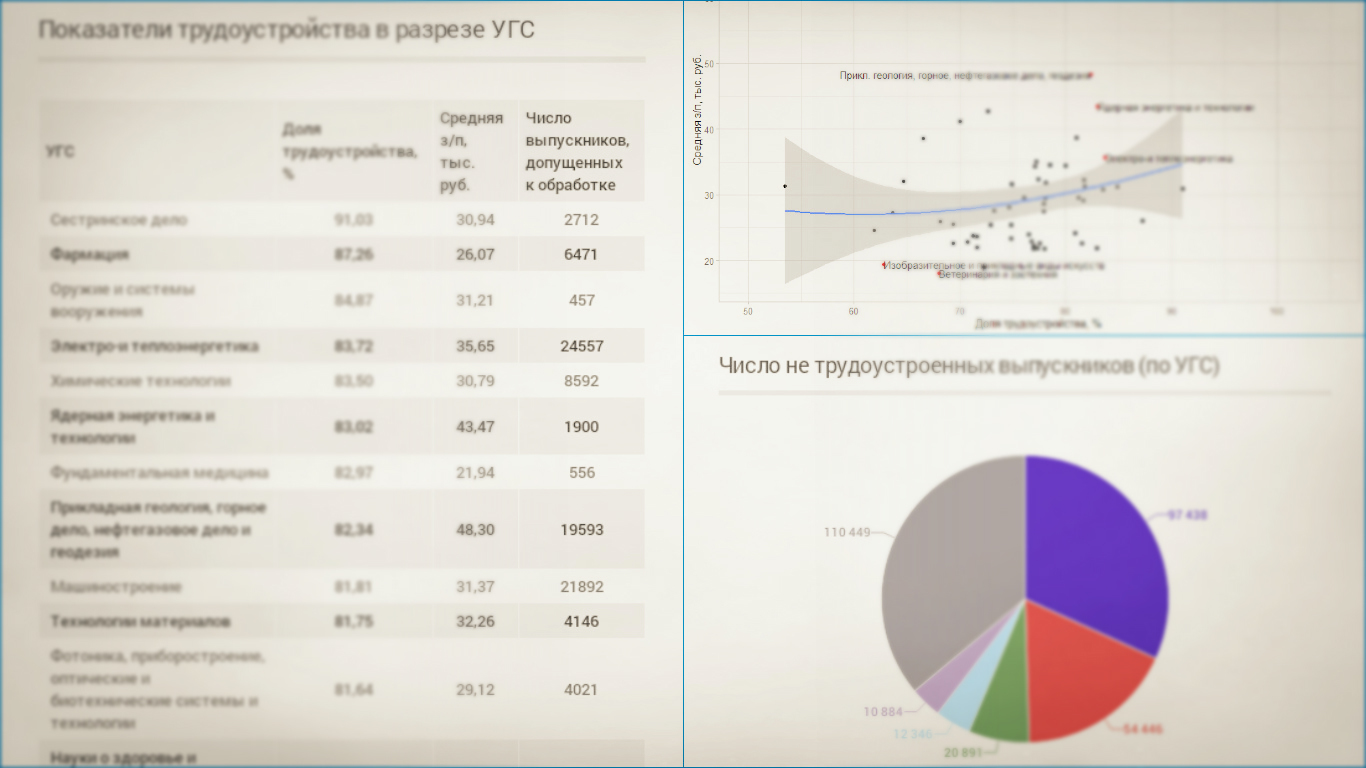
Hi, Habr!
In 2014, together with several ministries and departments, we launched the monitoring of employment of Russian universities, the results of which were published in 2015 on the portal http://graduate.edu.ru/ .
')
The monitoring was conducted among graduates of 2013 (they had enough time to find a job). Now we are working on monitoring graduates of 2014 and we decided to tell you about the goals and results of last year’s project. If you are interested to know how the salary and success of employment depends on the university, specialty and region, welcome under cat.
In the first part of the article we will talk about the goals, monitoring methods and baseline data. If you are interested only in the results, then you can go directly to the eponymous section .
purpose
The purpose of monitoring is to assess graduates' employment in the following cuts:
- University;
- Specialty (training direction);
- Geography of employment.
At the same time, two main parameters were evaluated:
- The share of employment (how many percent of graduates could find a job);
- The level of average wages.
Such an analyst is needed, for example, directly by the Ministry of Education and Science to evaluate the performance of universities. Employment of graduates is not the only, but an important criterion for such an assessment. Secondly, the results can be useful for graduates of schools and their parents. How to choose school, on Habré recently wrote . So, our information is relevant for those who are a little older, especially in the light of the upcoming introductory campaign.
Technique
Generally speaking, research on this topic is not so rare. Many universities have services that analyze the fate of graduates. Various media and online recruitment resources also like to please with similar statistics. And that's great. But this study is fundamentally different from them in the following:
- Scale - practically all Russian universities participated in the monitoring. At the time of monitoring, there were data on 1,240,532 graduates of 2013, indicating their full name, age, gender, specialty, qualification, and other attributes that were not very interesting to us.
- Data sources - Employee FIU data on employment and wages were used.
- Visualization - Convenient and accessible presentation of results on the portal http://graduate.edu.ru/ .
Monitoring consists of several stages:
0) At the “zero” stage, all higher education institutions are obliged to enter information about the issued diplomas into the federal information system . By the way, each graduate can check the availability of information on him in this register frdocheck.obrnadzor.gov.ru (as long as there is data on graduates only from 2013-2014 and partially from 2015). This service can also be used by employers. If you did not find yourself there, we highly recommend writing to your university about this.
1) At the first stage, all higher educational institutions were selected from the FRDO data (except for power, foreign, and those whose founders are religious organizations).
2) At the second stage, Rosobrnadzor checks and processes the information received for each graduate (in the protected FRDO circuit). Data on students who continue their studies are excluded (we assume that if a person continues to study further, then this is a good reason not to look for work). All graduates must be correctly filled: name, gender and date of birth, otherwise the FIU will not be able to identify them.
After that, the data are grouped into packages and transferred to the Pension Fund of Russia for processing. Each package corresponds to a unique combination of the following cuts: university, specialty, qualification, gender. In fact, this is the group of graduates who graduated from the university in one specialty.
3) At the third stage, the Pension Fund of Russia determines whether the graduate was employed according to official data (at least one contribution was made to the Pension Fund for the year or the individual entrepreneur was opened), and also how much the average graduate earned during his work by summing up these data each package.
4) The FIU transmits data on employment and wage levels for each group, i.e. in an impersonal form (it is impossible to understand how much your former classmate gets specifically).
All this data is analyzed and uploaded to the Portal.
For those who are confused, the technique is shown in a separate figure:

Fig. one
Based on the data obtained from the FIU, two main indicators are calculated:
- Share of employment. This is the ratio of the number of employed graduates to the total number of university graduates minus the “erroneous” and not found FIUs.
The final formula will look like this: where
where
Ktd - the number of employed graduates,
Ko - the total number of graduates selected at stages 1 and 2,
Kosh - the number of graduates with incorrect data, such as an empty date of birth,
- the number of graduates who could not uniquely identify the FIU (full namesake by name, gender and date of birth)
Cinema - the number of graduates - citizens of foreign countries (applicable only for the university and more general sections - type of university, university region, etc.).
For convenience, the Ko-Kosh value will be called the “number of approved for processing”.
When calculating the share of employment in the whole university or region, foreign students are also deducted (for them, using the data of the domestic FIU is not entirely correct). In terms of specialties, such data in this monitoring could not be collected, therefore, for them, the share of employment is calculated without deducting foreigners. - The level of average wages. In fact, it is not only wages. This is all the money officially earned by a graduate (salaries, bonuses, etc.) for the entire calendar year following the year of graduation (that is, payments for the entire 2014 were analyzed for graduates of 2013).
The average salary is calculated as this total income divided by the number of months the graduate worked in 2014.
Features of the technique
Obviously, such a technique (like any other) has both advantages and disadvantages.
The cons are obvious:
- Only official employment is taken into account (if the graduate has become a freelancer, but he has not registered an individual entrepreneur, then he will be considered unemployed);
- Only official incomes are taken into account (side jobs and gray salaries will not fall into the data of the FIU);
- The fact of compliance of the graduating specialty and the sphere of employment is not tracked (a joke about the humanities and McDonalds).
All these disadvantages are quite difficult to eliminate, if we confine ourselves to official data sources. Theoretically, you can try to get them through questionnaires / surveys, etc. But, firstly, it will introduce its distortions in the data (more than one hundred articles were written on the subject of distortion by the respondents of their income level), and secondly, it would be comparable to a mini-census for Russia to get a representative sample of all necessary cuts. population.
Fortunately, the cons are both advantages. The main advantage of the method is that the sample is almost complete (minus graduates who have continued their education and data provided with errors). This means that the error of representativeness is minimized, since we work almost directly with the general population.
Unfortunately, this was the first monitoring project and it did not take into account some factors: the form of study (full-time / part-time), the first or second higher education, and the form of payment. All this is taken into account in the monitoring of graduates in 2014, which is now in full swing.
Input data
Total universities participating in the monitoring - 933 (excluding branches):
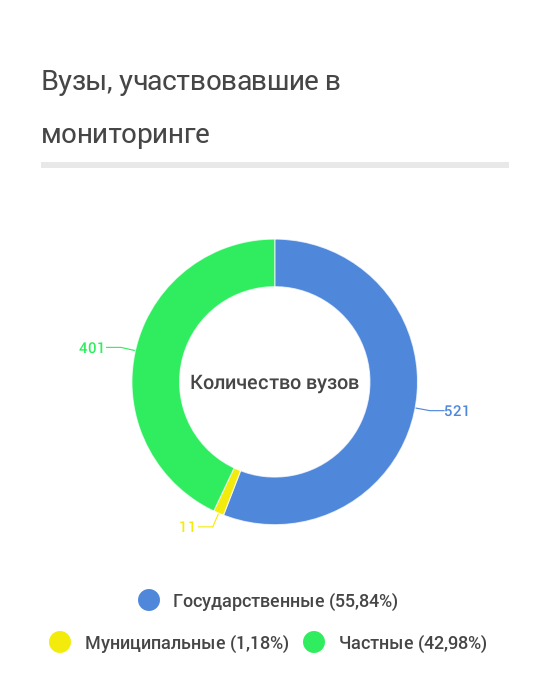
Fig. 2 ( interactive )
Not all of them have passed the correct data (for various reasons, "private traders" have failed in the main):
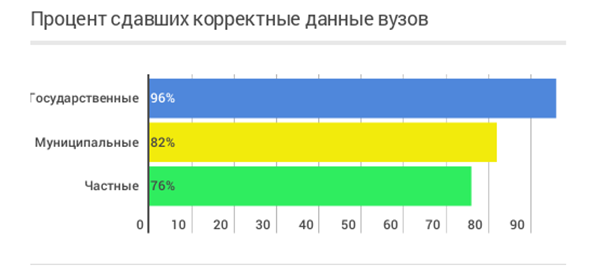
Fig. 3 ( interactive )
In total, we got 819 universities, which provided data on 1,240,532 graduates:

Fig. 4 ( interactive )
Let's see how graduates are distributed by types of universities (the number of graduates will be considered taking into account branches, unless otherwise indicated):

Fig. 5 ( interactive )
As can be seen, the percentages compared to Figure 4 are different. But it is quite logical - there are many large among state universities, much less among private ones.
Each graduate was trained in the direction related to one of the enlarged groups of areas of training (specialties), in abbreviated form - UGS. For example, "engineering", "economy and management", etc. There are more than 50 such UGSs. In order not to give such a “sheet” here (we will look at it later), we will group the data according to the UGS type. The classification is rather conditional, but such a breakdown is present in various regulatory acts in Russia.

Fig. 6 ( interactive )
In fact, economics and law are part of the “science of society”, but their rates were so high (35% of all graduates are “economists”) that they had to be divided into separate categories.
About 3% of graduates continued their education, another 0.4% of the data turned out to be incorrect (mostly incorrect or unfilled birth dates) and 1 198 276 people “left” for processing. Their data served as the basis for the results outlined below.
results
Given the volume of the data array, its analysis can be performed for a huge number of sections and a variety of hypotheses can be tested on its basis. Therefore, here we present only some results of the analysis. This is only a small part of what can be obtained by studying the monitoring data.
For those who want to work independently with the data (or just look at their home university) - detailed results for all universities can be seen on our portal. After registration (without SMS), you can download this data in Excel format:
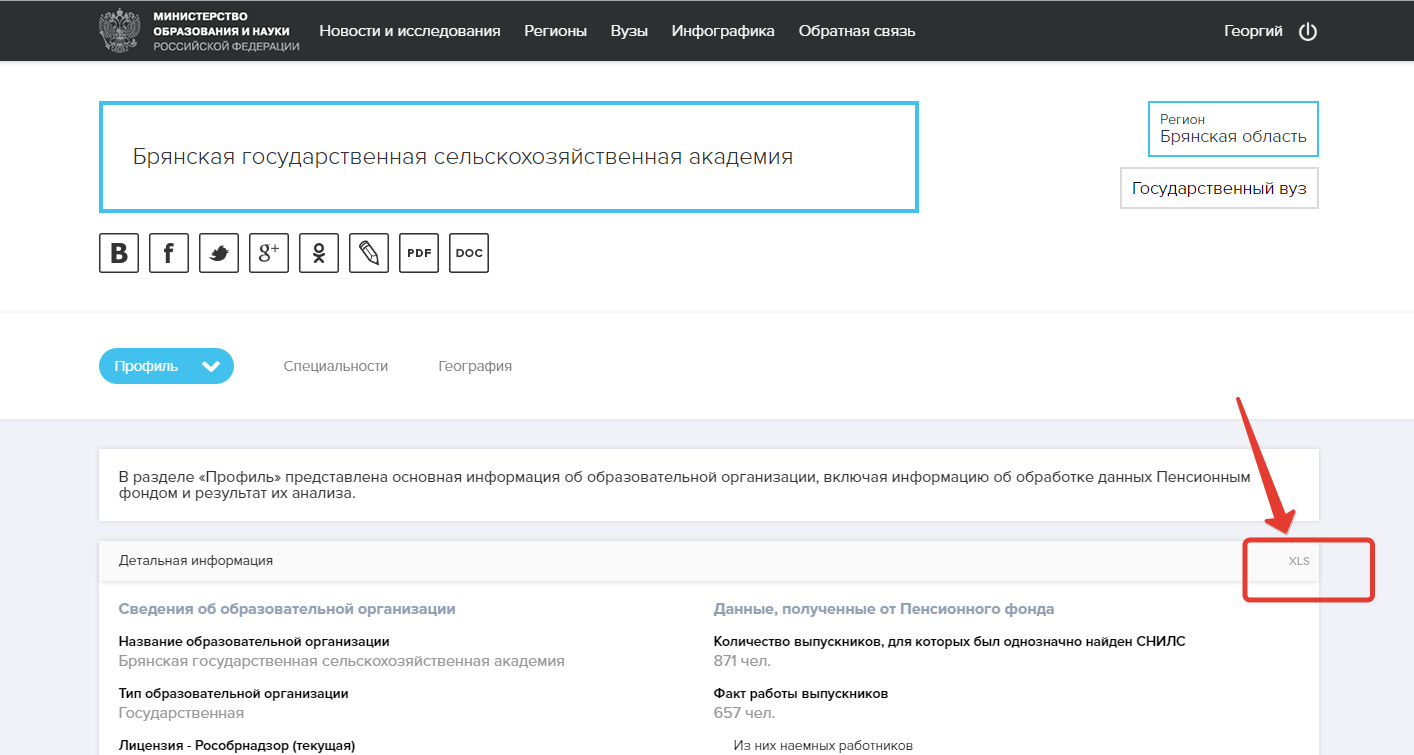
Fig. 7
In this article we will not consider the data in the context of universities - there is information on them on the portal, and there is not enough space for such an analysis. We can only say that the first places are small and not the most famous universities. There is nothing strange in this: the smaller the university, the more chances it has to show the indicator deviating from average values.
Before proceeding to a direct statement of the results - a small remark for those who rarely deal with statistics. In the general case, when it comes to statistical laws, we cannot talk about what is the cause, and what is the consequence. If graduates of a prestigious university NN have good incomes and easily find a job, this does not mean that this is the university’s merit. Many talented and capable students come to prestigious universities, it is likely that they would have reached the same or even greater heights, studying in another university. The answer to such questions is the subject of a separate large study.
Analysis results
To start, look at the result of employment and wages by type of university:

Fig. 8 ( interactive )
Partly the expected result: according to statistics, in state universities in terms of employment, it is better to study than in the conditional "Natalia Nesterova Academy" (no offense to graduates of this university).
However, at the level of wages, it is not very affected. But municipal universities "subside." Perhaps because they are all concentrated in regions where wages are lower than in Moscow or St. Petersburg.
Now we will give the same schedule, but in the context of specialties (more precisely, the “EGS” - enlarged groups of specialties):

Fig. 9 ( interactive )
The table shows a column with the number of graduates for each UGS, so that you can estimate the number of employed students not only as a percentage, but also in absolute numbers.
As you remember, there is no competition for the number of graduates in economics and management. The top three also includes teachers and lawyers. Moreover, if economics and pedagogy are still in the middle of the “tournament table” in terms of employment, then jurisprudence is a definite outsider. If you look at absolute numbers, then about half of all unemployed graduates are lawyers and economists:

Fig. 10 ( interactive )
At the same time, differences in the results of a job search between representatives of these two specialties and other graduates are statistically significant (

Please note that in terms of employment, specialties of technical, medical and natural sciences are leading. Among those who lag behind are mainly “humanists” and creative specialties.
The following specialties lead in salary :
- Air navigation and operation of aviation and rocket and space technology - 69 470 rubles.
This is not surprising, given the salaries of civil aviation pilots in Russia. - Applied geology, mining, oil and gas business and geodesy - 48,290 rubles.
Given the current situation, it will be interesting to look at this industry in the dynamics of the next years. - Nuclear power and technology - 43 460 rubles.
But this is a pleasant surprise. - Physical culture and sport - 42 700 rubles.
It is unlikely that children's coaches and other specialists in this field receive high salaries, but in order to raise the average value, a small number of professional footballers / hockey players receiving fabulous fees are enough. - Screen art - 41 150 rubles.
Most likely, the situation is similar to that described in the previous paragraph.
It will be interesting to look at the specialty at the same time and in terms of the proportion of employment, and in terms of wages. That is, to identify "twice the best" and "twice the worst." To do this, select the UGS, in which the average salary and the level of employment will be lower (for the “worst”) or higher (for the “best”) of the 15th and 85th percentile of the distribution of these values, respectively. Such a division is conditional, but for clarity, we limit ourselves to it (a more detailed analysis can be carried out using the above table and portal data).
In the following picture, the “worst” and “best” specialties are highlighted in red and signed:
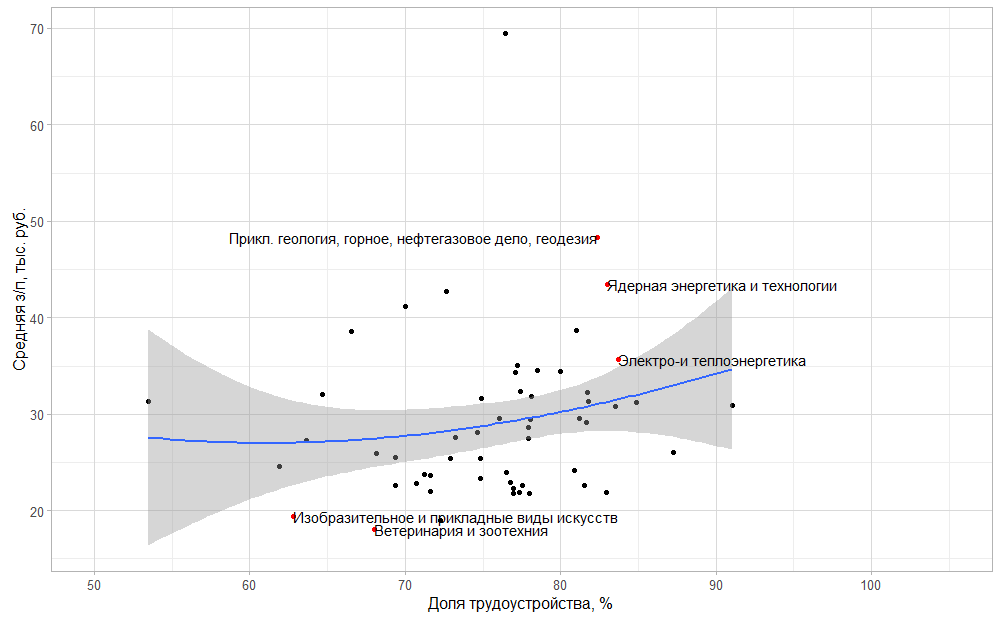
Fig. eleven
So if you are an applicant and after graduating from high school do not want to have problems with employment and salary, go to nuclear physics :-)
Let us turn to another important indicator - geography.
Universities in which regions have the best employment rates? For convenience, we will take into account only the head organizations, since in general it is not clear whose university to consider the Vladivostok branch of a Moscow university - Moscow or still Far Eastern. Accounting geography of branches - the topic of a separate article.

Fig. 12 ( interactive )
As can be seen, the greatest problems with employment indicators are mainly in the universities of the North Caucasus. If you look at the list of university regions with the worst employment rates in the Russian Federation, we will see this again:
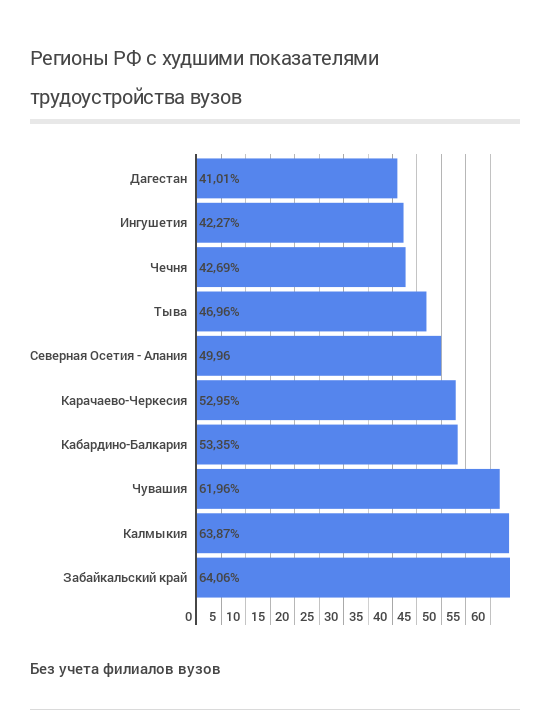
Fig. 13 ( interactive )
Here it is worth noting the high unemployment rate in these regions. According to Rosstat , in the North Caucasus Federal District it is twice as high as the national average. But it is impossible to say unequivocally what is the cause and what the consequence. Unemployment can be caused by a small number of job vacancies, and perhaps by the low quality of specialists or the reluctance of regional residents to get employed in (official) work.
If we are talking about geography, we want to touch on the topic of labor migration. More detailed data on the migration of graduates of a university or region, including the salary levels of those who left / left can be viewed on the portal in the list of regions http://graduate.edu.ru/registry#/?slice=6 .
Take a look at the map showing the percentage of graduates who left the region (relative to the total number of employed graduates from this region). This time the branches participate - we consider their graduates as graduates of the region where the branch is physically located:
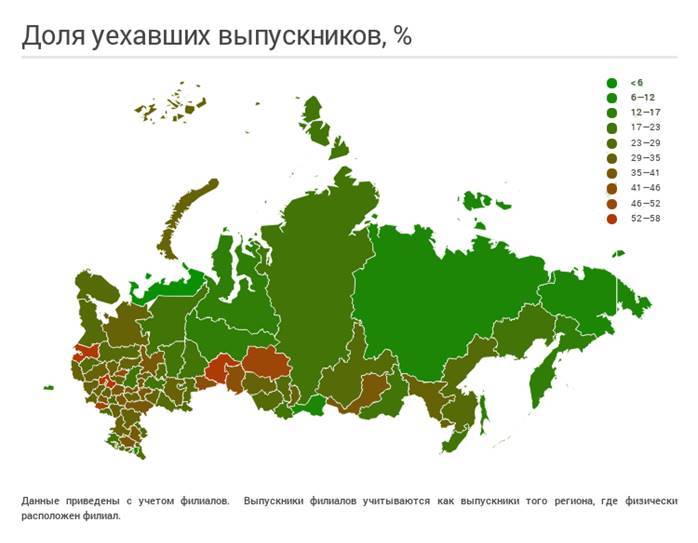
Fig. 14 ( interactive )
To find out the specific reasons for the high outflow of graduates, it is necessary to analyze each region separately. For many neighboring regions, the situation is similar: graduates are leaving the “graduating” region to the neighboring one. Perhaps this is just the return of graduates home after graduation. Or maybe the neighboring region is just the closest one in which it is easy to find a good job. For example, from the Tomsk region, many leave for neighboring Novosibirsk and Kemerovo. The situation is similar with the Tyumen region and KhMAO.
In Moscow, the share of graduates who left is unexpectedly high. And 18 thousand moved to the suburbs:
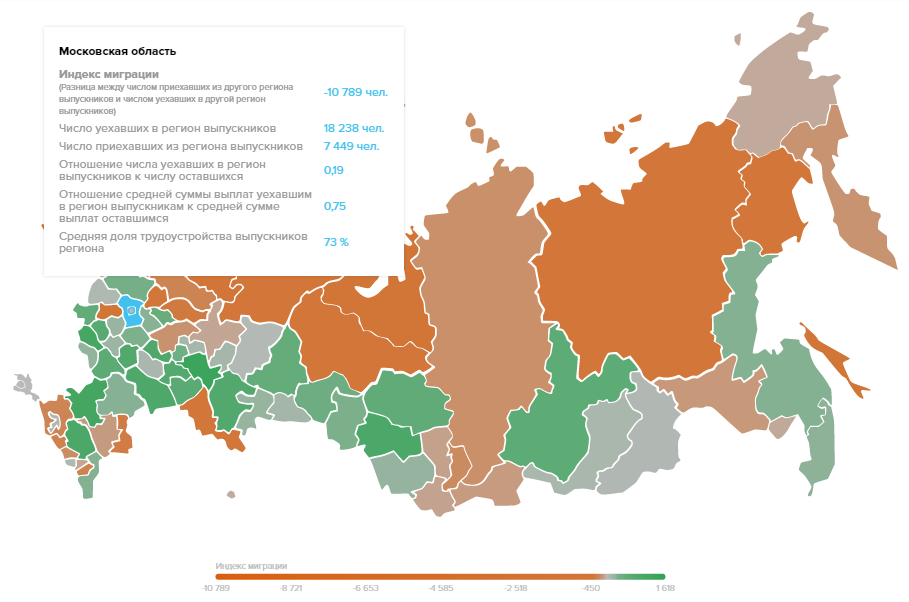
Fig. 15 ( interactive )
This is due to legal formalities. Many branches of Moscow universities, at the end of their studies, transfer their students to the “head office” organization. So a person who lives and works in the region receives a diploma as a graduate of a Moscow university, and not a branch.
But the Kursk region reflects the all-Russian trend - its graduates leave mainly to Moscow (about half of the graduates leave). We suspect that this is due to the difference in the level of wages - for those employed in Moscow, it is 2 times higher than for the rest. In general, in almost half of Russia's regions, the most popular destination for graduates is Moscow and the Moscow Region.
Instead of conclusion
We told only about a small part of the data obtained and studied during the monitoring. But this is the time to round out - the article and so it came out not small. We hope you were interested to know about the project and some of its results. If it is interesting, SAnatoly can talk about the start and methodology of the project, and vpodolskiy about the architecture and the formation of packages for the FIU.
It should be remembered that such monitoring is not the only way to assess the effectiveness of universities and has a number of limitations and assumptions. Despite this, the results of the project provide enough food for thought and, perhaps, will help applicants to choose a profession or university.
We are waiting for everyone who is interested in this post, on the portal - and just curious, and specialists in the field of education, and those who would like to independently analyze the data.
Source: https://habr.com/ru/post/302930/
All Articles